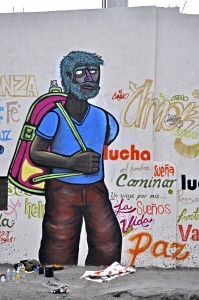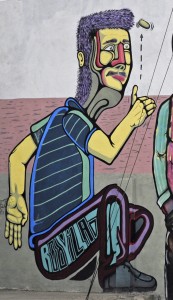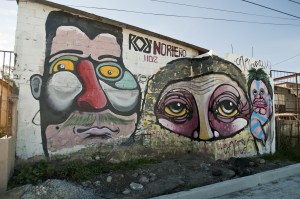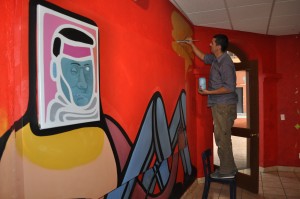A prolific street artist, Rod Villa Osuna has been painting large-scale murals for years in his home streets of Mexicali, Baja California. In the past two years, prestigious commissions to paint murals at Facultad de Ciencias Humanas building at Universidad Autonoma de Baja California and at the Pasaje de Arte in Mexicali have earned him much deserved attention statewide in Baja California.
This month, art lovers and collectors in Southern California will have a chance to see Villa’s work up close. Rod Villa’s new 19-piece collection, titled “Callar y Producir,” will be showing through the month of October at Santos Fine Art Gallery in Encinitas, California.
And it is precisely this productive engagement between the artist and the viewer that brings Rod Villa back to the street, again and again.
“One of the things that drives me to keep doing this is the immense reaction among a certain type of people, Rod told me last week in an interview on Facebook chat. “A barrage of migrants from everywhere offer some really crazy interpretations, and others that are very wise. Only by making murals do you feel this interaction between the spectator and the creator.”
“Una de las cosas que impulsan mucho a seguir haciendo esto es la reaccion inmensa en cierto tipo de personas,” me comentó Rod la semana pasada en un entrevista por Facebook chat. “Un bombardeo de migrantes de todas partes [ofrecen]algunas interpretaciones muy locas y otras muy acertadas. Solo haciendo muros se siente esa interaccion entre el espectador y el creador.”

Rod Villa's migrant character is part of a group mural on the facade of La Nueva Vision, a drug rehabilitation center in central Tijuana, on the corner of Av. Internacional and Niños Heroes
Thanks to the “indigenismo” movement of José Vasconcelos, the first Secretary of Public Education under President Álvaro Obregón in the 1920s, these muralists were funded by the Mexican government. Yet the three masters were violently attacked, their powerful narratives dismissed as “monstrosities.” Similarly, American artist Ben Shaun, who assisted Diego Rivera on his ill-fated mural at Rockefeller Center, was dismissed by critics for the alleged “political motives” of his social realism.
But it would be a mistake to view this tradition only through the lens of historical content. What the modernists achieved in the early decades of the 20th century was to give aesthetic form to a dawning sense of anomie. Ecstatic optimism in the power of machines to make life better was crushed by brutal events of the age.
Social theorists responded, positing an “iron cage,” a dark force of instrumental reason at the heart of the machine age. In Orozco’s image “Barricade” (1931) or Siqueiros’s “America Tropical” (1932) the artists craft tension and contradiction into aesthetic form, the bold lines and clear geometric forms of cubism turning emotion into form.
Like the modernists before him, Rod Villa draws directly from the graphic traditions of magazine illustration, comics and poster art for his bold geometric forms and characters. A fan of Japanese comics and skateboarding magazines in high school, Villa notes that these influences enabled him to express a more irreverent sense of humor and style.
Yet, the great masters provided a balance.
“Taking a hand in this was my uncle, my mother’s brother, recalls Villa. “He always brought me books of the great painters like Toulouse-Lautrec, Siqueiros, and so I was always in the middle of these two graphic worlds.”
“Tomando de la mano de eso mi tio, el hermano de mi madre,” relata Villa. “Siempre llevaba libros de grandes pintores Toulouse-Lautrec , Siqueiros y era como estar en medio de dos mundos graficos.”
Growing up in a world saturated with pop culture images, Villa sees our consumer society as a trap that prevents people from becoming genuinely creative.
Employing the strong bold lines of the graphic novel tradition and cubism, Villa embeds his characters in dense geometric networks expressive of the tension between ebullient desire to create and the immobilizing, rational force of machine logic. Exaggerated arms extend like cables, turning into machines, characters face each other, legs and bodies interwoven through processes of work and play.“While people talk about art and criticize art, in reality, they rarely get down to producing,” says Villa. “And I believe that we ought to speak by producing. Hence the name of the show.”
“La expo gira alrededor de lo que la gente siempre habla de arte y critica al arte o a las producciones, comenta Villa. “Pero en realidad no se pone a producir. Y yo creo que uno debe hablar con produccion, y por eso el nombre de la expo.”
Villa begins with the image of totality in the foundation of a work, and then builds from there.
“The play of black on the background and the colors over it gives me the idea that I’m putting together a puzzle, segments that fit together into a totality,” Villa explains. “This is the way I build a lot of the time.”
“El juego del negro de fondo y colores sobre de ello me da una idea de que estoy armando un rompecabezas de segmentos que conforman una totalidad,” explica Villa. “Es mi forma de construir en muchas ocasiones.”
While his works capture the paralyzing forces of consumerism, mass-production and labor, Rod Villa’s images remain full of life and movement and humor.

Detail from group mural on the facade of La Nueva Vision, drug rehabilitation center in central Tijuana
Rod Villa’s collection will be on display exclusively at Santos Fine Art Gallery in Encinitas, CA from October 1-31, 2012. A special artist reception is scheduled for October 13, 2012 from 6-10PM at Santos Fine Art Gallery, 978 N Coast Highway, Encinitas, CA. For more info, call the gallery at 760.633.1644, and contact them online at SantosFineArtGalleries.com. Private showings are available by request.
For more of Rod Villa’s images, follow him on Flickr
Click here for a video of Rod Villa painting his mural “Relaciones de Poder”
Video by Bodega
“Relaciones de Poder” from BODEGA on Vimeo.


